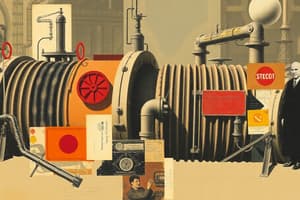Podcast
Questions and Answers
What is the primary purpose of a double pipe heat exchanger?
What is the primary purpose of a double pipe heat exchanger?
- To mix two fluids of different temperatures
- To cool a hotter fluid with a colder fluid
- To increase the surface area of the fluids
- To heat a colder fluid with a hotter fluid (correct)
When is a shell and tube heat exchanger preferred over a double pipe heat exchanger?
When is a shell and tube heat exchanger preferred over a double pipe heat exchanger?
- For small load applications
- For heating fluids with very high temperature differences
- When the surface area needed is low
- For applications requiring large surface areas (correct)
In a double pipe heat exchanger, how can hot water and cold water enter?
In a double pipe heat exchanger, how can hot water and cold water enter?
- Either by co-current or countercurrent directions (correct)
- Only in counter-clockwise direction
- In a turbulent manner
- Simultaneously
What is the equation used to calculate heat transfer, Q, in any operating condition?
What is the equation used to calculate heat transfer, Q, in any operating condition?
What does 'U' represent in the equation for heat transfer Q?
What does 'U' represent in the equation for heat transfer Q?
When would the shell and tube heat exchanger be chosen over the double pipe heat exchanger?
When would the shell and tube heat exchanger be chosen over the double pipe heat exchanger?
What is the formula for log mean temperature difference (LMTD) in a heat exchanger?
What is the formula for log mean temperature difference (LMTD) in a heat exchanger?
What is the formula for heat transfer, Q, in a heat exchanger?
What is the formula for heat transfer, Q, in a heat exchanger?
Which equation represents the log mean temperature difference (LMTD) as a function of the temperature of the hot and cold fluids?
Which equation represents the log mean temperature difference (LMTD) as a function of the temperature of the hot and cold fluids?
What is the purpose of switching on the pump for hot water without turning on the heater in the experiment procedure?
What is the purpose of switching on the pump for hot water without turning on the heater in the experiment procedure?
What does 'steady state' refer to in the context of recording temperature data during the experiment?
What does 'steady state' refer to in the context of recording temperature data during the experiment?
In which direction is the cold water flow initially set during the experiment procedure?
In which direction is the cold water flow initially set during the experiment procedure?
What does 𝑇𝑐 represent in the context of recording temperature data in the experiment procedure?
What does 𝑇𝑐 represent in the context of recording temperature data in the experiment procedure?
What is the main factor for calculating log mean temperature difference (LMTD)?
What is the main factor for calculating log mean temperature difference (LMTD)?
Why is it important to set the flow rate of hot water supply to a steady rate before switching on the heater?
Why is it important to set the flow rate of hot water supply to a steady rate before switching on the heater?
What does $𝐿$ represent in the formula for log mean temperature difference ($Δ𝑇_{log}$)?
What does $𝐿$ represent in the formula for log mean temperature difference ($Δ𝑇_{log}$)?
What does $rac{T_{h1}+ T_{c1}}{T_{h2} + T_{c2}}$ represent in the formula for heat transfer ($Q$)?
What does $rac{T_{h1}+ T_{c1}}{T_{h2} + T_{c2}}$ represent in the formula for heat transfer ($Q$)?




